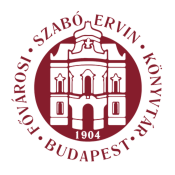Hajós György: Heroes' Square - Our Budapest (Budapest, 2001)
ernmental authority he bought important works in Italy after 1884; his purchases there included Piombo’s Portrait of a Man. As early as the period when the Esterházy collection was acquired, the idea was raised that a building suitable for the simultaneous exhibition of the collection should be erected. The proposition submitted by the prime minister in January of 1894 named the area beyond the City Park Lake towards the Zoo as the site of the planned museum building. Detailed plans prepared in the second half of the same year suggested that the construction be raised on a plot lying in the extension of Andrássy út beyond the bridge. The treasury took on itself the expenses on condition that the municipality of Budapest relinquish its ownership of the area gratis. The municipal authorities would not part with the site, however, as they wanted to prevent any further diminishing of the city’s leafy areas. Kálvin tér, (Jjvásár tér (today’s Köztársaság tér) Szabadság tér and the place where the Rókus Hospital (a building meant to be demolished) and several spots along the Danube bank were all suggested as alternative sites, but none proved to be suitable for a building of such proportions. Talks were under way when Parliament enacted and the king endorsed Act VIII of 1896 providing for the erection of public monuments meant to commemorate the Millenary of Hungary’s statehood. Section one of the Article provided for the establishment of the National Museum of Fine Arts and the erection of a building to house its collection. Legislation earmarked 3,200,000 koronás for the purpose stipulating that approximately 2 million be spent on new acquisitions for the collection, making the remaining 1.2 million available for the construction of the building. Ernő Kämmerer, the government commissioner put in charge of implementing the project, struck an agreement with the city. Cinder the agreement the latter relinquished the area where the building stands to this day. The contract, approved by the capital at the board meeting of 9-10 March 1898 on the one hand and countersigned by the minister of religion and culture on 29 July on the other, stipulated that the capital surrender the site gratis, but the government pay 100 twenty-crown 44
